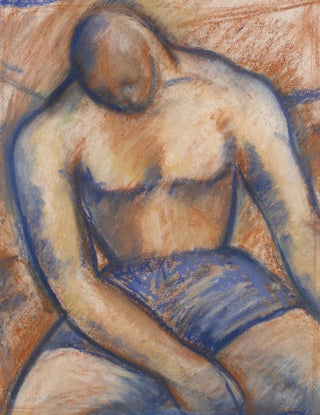Art print | Seated Boxer - Mark Gertler


View from behind

Frame (optional)
"Boxeur assis" is an iconic artwork by Mark Gertler, a British artist whose work marked the early 20th century. This painting, which evokes human strength and vulnerability, stands out for its emotional intensity and bold aesthetic. Through this piece, Gertler captures not only the athletic figure of the boxer but also a deeper essence of the human condition. The viewer is invited to contemplate a moment of pause, reflection, where physical power blends with a certain melancholy. The art print of "Boxeur assis - Mark Gertler" allows for appreciation of this duality, offering a window into the artist's soul and the universal themes he explores.
Style and uniqueness of the work
Gertler's style in "Boxeur assis" is characterized by a daring use of colors and shapes. The artist plays with vivid and contrasting hues, creating an atmosphere that is both energetic and contemplative. The lines are both fluid and angular, emphasizing the boxer's musculature while suggesting a certain fragility. This contrast between physical strength and emotional sensitivity is at the heart of the piece. The composition, centered on the figure, immediately draws the eye and encourages introspection on the nature of strength and weakness. Gertler manages to transcend the simple portrait to offer a reflection on the human soul, making this work timeless and universal.
The artist and his influence
Mark Gertler, born in 1891, is one of the major representatives of the British artistic movement of the early 20th century. Influenced by post-impressionism and fauvism, his work is distinguished by a bold approach to color and form. Gertler was able to capture the concerns of his time, notably social tensions and cultural upheavals that marked British society. The art print of "Boxeur assis" fits into this lineage, bearing witness to his commitment to exploring themes such as struggle, resistance, and vulnerability. The artist also played a key role in the development of modern art in Great Britain.

Matte finish

View from behind

Frame (optional)
"Boxeur assis" is an iconic artwork by Mark Gertler, a British artist whose work marked the early 20th century. This painting, which evokes human strength and vulnerability, stands out for its emotional intensity and bold aesthetic. Through this piece, Gertler captures not only the athletic figure of the boxer but also a deeper essence of the human condition. The viewer is invited to contemplate a moment of pause, reflection, where physical power blends with a certain melancholy. The art print of "Boxeur assis - Mark Gertler" allows for appreciation of this duality, offering a window into the artist's soul and the universal themes he explores.
Style and uniqueness of the work
Gertler's style in "Boxeur assis" is characterized by a daring use of colors and shapes. The artist plays with vivid and contrasting hues, creating an atmosphere that is both energetic and contemplative. The lines are both fluid and angular, emphasizing the boxer's musculature while suggesting a certain fragility. This contrast between physical strength and emotional sensitivity is at the heart of the piece. The composition, centered on the figure, immediately draws the eye and encourages introspection on the nature of strength and weakness. Gertler manages to transcend the simple portrait to offer a reflection on the human soul, making this work timeless and universal.
The artist and his influence
Mark Gertler, born in 1891, is one of the major representatives of the British artistic movement of the early 20th century. Influenced by post-impressionism and fauvism, his work is distinguished by a bold approach to color and form. Gertler was able to capture the concerns of his time, notably social tensions and cultural upheavals that marked British society. The art print of "Boxeur assis" fits into this lineage, bearing witness to his commitment to exploring themes such as struggle, resistance, and vulnerability. The artist also played a key role in the development of modern art in Great Britain.






